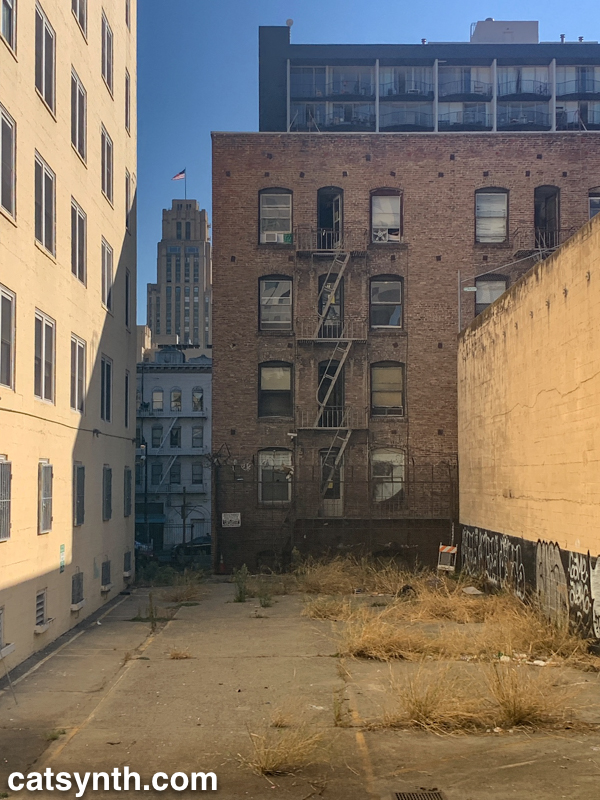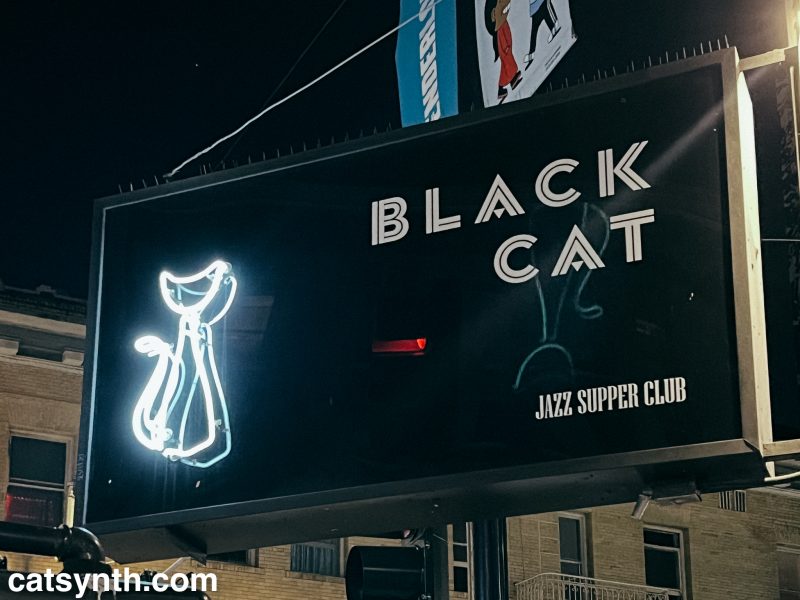
tenderloin
Wordless Wednesday: Architectural Layers (Tenderloin, San Francisco)
Compton’s Cafeteria Series
This past Thursday, the Center for New Music launched Compton’s Cafeteria Series, a set of occasional concerts featuring transgender performers. And I was there both the cover the show and be a part of it!
For those who are not familiar with the story, Gene Compton’s Cafeteria was a small restaurant chain and its Tenderloin location at the corner of Taylor and Turk Streets was one of the few places where transgender individuals, and especially transgender women, could safely congregate. There was, however, some tension between transgender patrons and the staff, who often called the police, with arrests and harassment ensuing. In 1966, this pattern led to the Compton’s Cafeteria Riots.
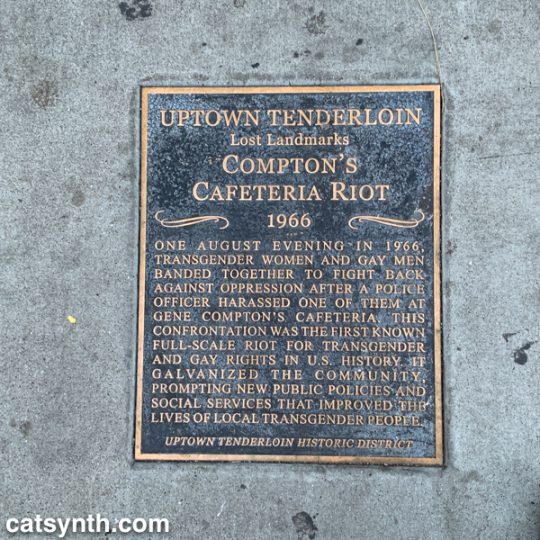
In the 1960s the Compton’s Cafeteria staff began to call the police to crack down on transgender individuals, who would frequent the restaurant.[8]Management felt that transgender customers were loitering and causing them to lose more desirable business. In response, they implemented a service fee directed at transgender individuals and blatantly harassed them in an attempt to get them to leave the restaurant.[8] In response to police arrests, the transgender community launched a picket of Compton’s Cafeteria.[9] Although the picket was unsuccessful, it was one of the first demonstrations against police violence directed towards transgender people in San Francisco.[9] On the first night of the riot, the management of Compton’s called the police when some transgender customers became raucous. Police officers were known to mistreat transgender people.[10]When one of these known officers attempted to arrest one of the trans women, she threw her coffee in his face.[2] According to the director of Screaming Queens, Susan Stryker, the cafeteria “erupted.”[5]
https://en.wikipedia.org/wiki/Compton%27s_Cafeteria_riot
This was nearly three years before the Stonewall Inn Riots in New York but has not gotten nearly the visibility in the time since. There is a plaque on the sidewalk in front of the former site at 101 Turk Street, and there is now an honorary street renaming of the 100 block of Taylor Street as Gene Compton’s Cafeteria Way – we featured the sign in our most recent Wordless Wednesday post.
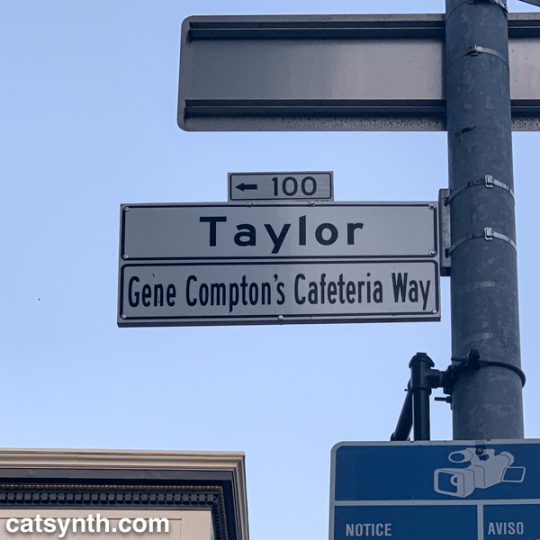
More importantly, the immediate vicinity has been recognized by the city as a “Transgender Cultural District.” As the Center for New Music is located in the heart of this new district, it seemed natural for them to host a series celebrating transgender visibility (and audibility), and I am grateful to the staff there and to my friend David Samas for proposing this and making it happen.
The show itself was a successful event featuring vary different performances, although they all made extensive use of hardware synthesizers. You can see some of the highlights in my latest video.
The evening started with a set by Rusty Sunsets (aka Cara Esten). Her performance was divided into two sections, the first featuring acoustic guitar and voice, and the second incorporating synthesizers and drum machines. Both parts were unified by Esten’s folk-song style, with a series of compositions about her upbringing in Oklahoma and loves lost and found. Perhaps the poignant was a love song inspired by the 1911 Triangle Factory fire in New York where 146 workers, the vast majority of whom were women, perished. My favorite was the final song which brought together a Moog Mother-32 and other synthesizers with plaintive but optimistic singing.
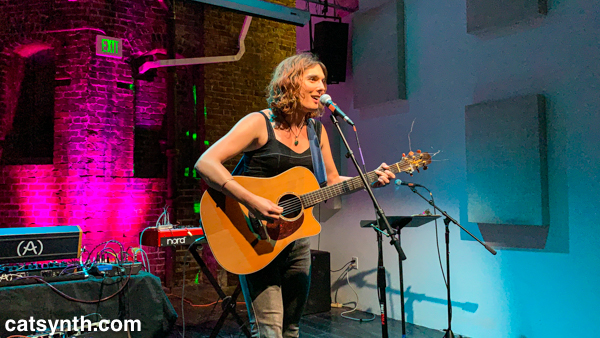
Next up was Pitta of the Mind (Amanda Chaudhary and Maw Shein Win). We performed a short set with a featured color of blue – set against the fuschia background lighting and my automated multicolor blinking lights. Musically, it had a very punctuated quality with abstract sounds from the modular and Arturia MicroFreak against some of Maw’s poems that featured open space and short lines. We mixed it up for the final piece, which had lusher and more emotive quality with longer lines and acoustic piano – these pieces are a strength for us and we always include at least one.
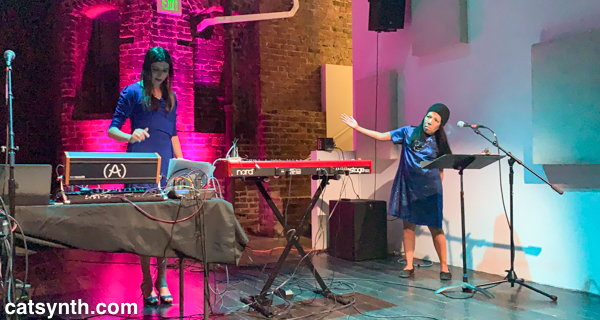
Then it was time for the final set, featuring my solo electronic performance. I started with the solo version of White Wine (and a cup of white wine). The Casio SK-1 was sampled and remixed in Ableton Live, with the statement of the melody and cords, followed by a cacophony leading into two distinct rhythmic sections: first a funk/disco sound featuring MicroFreak bass and a jazz piano improvisation; and then a Stereolab inspired electric-organ solo leading into a final section of tape-delayed metallic sounds (Strymon Magneto and Pocket Gamelan from Crank Sturgeon).
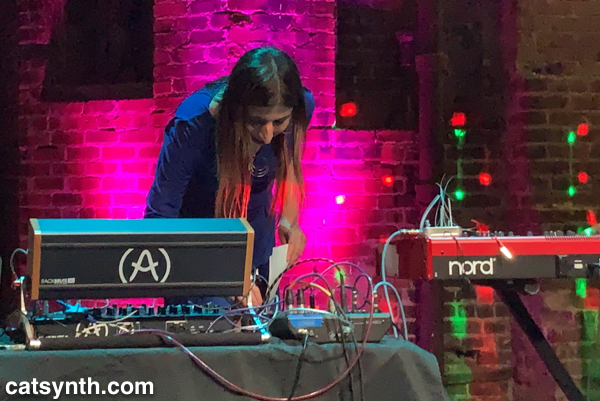
After that, it was on to the cat-infused and disco-and-French-House inspired Donershtik. The piece is just a lot of fun, a classic 70s analog melody (in this case on the Arturia MiniBrute) in Phrygian mode followed by playful modular improvisation (anchored by the MOK Wavewazor) going into the electric piano disco/house section.
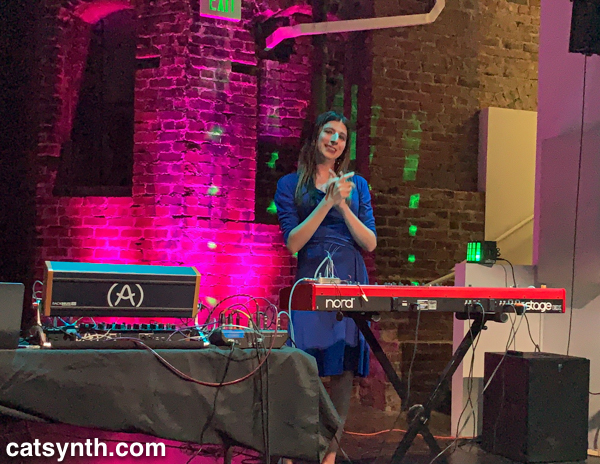
Overall, I think this was one of the best of my live solo sets, tightly choreographed with a relatively diverse and robust setup, and well-defined and well-rehearsed pieces. Once again, structure and hard work paid off.
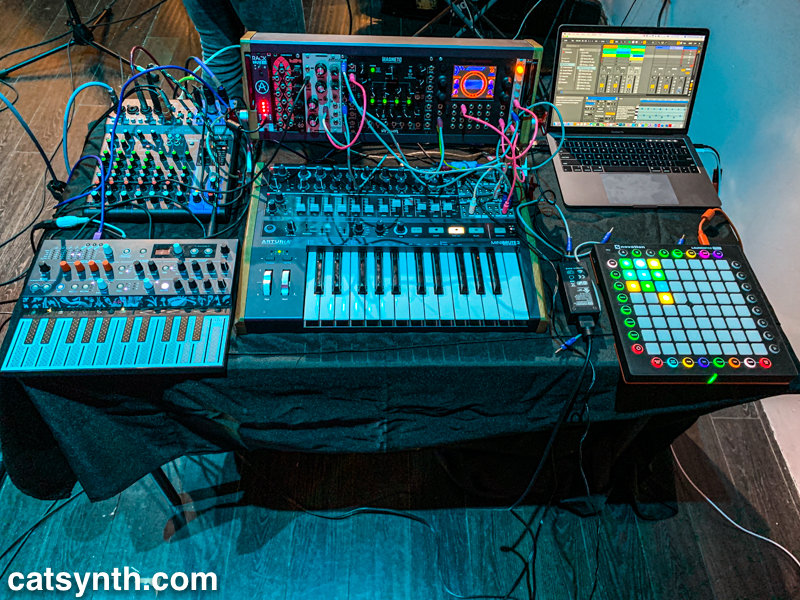
But I also fed off the positive energy and enthusiasm of the crowd, which brought together regular friends and fans with members of the transgender community. It was a beautiful night overall, and I look forward to both being present and helping organize the next in this series.
(Not so) Wordless Wednesday: Compton’s Cafeteria Way
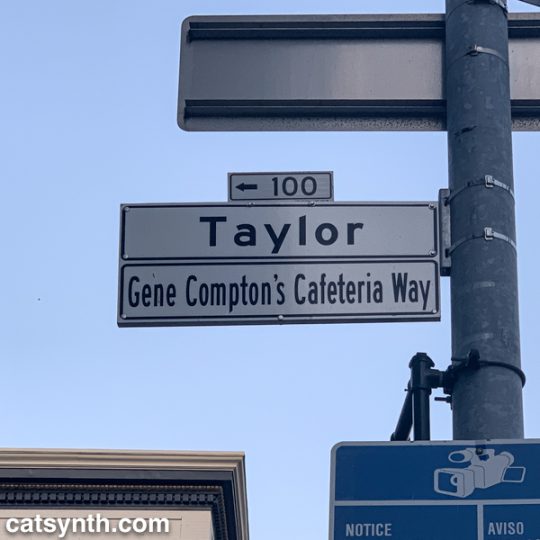
In 2016, the 100 block of Taylor Street (between Turk and Eddy) was designated as Gene Compton’s Cafeteria Way for the 50th anniversary of the Compton Cafeteria Riots, a riot and protest by transgender people, drag queens, and others two years before the famous Stonewall Inn Riot in New York. I happened to be at the unveiling during Pride 2016 and can read my report here.
The Center For New Music, which is half a block north on Taylor Street, is launching a series commemorating its famous neighbor and transgender awareness and activism. I am proud to be one of the inaugural performers: you can find more about the show this Thursday here.
Finally, you can also read my article about walking the entire length of Taylor Street.
SF Trans March 2016
It is pride weekend in San Francisco, and it is a particularly poignant one after the shootings in Orlando only two weeks ago. It is an extra mission for many of us to show up this year and be present, and be defiant. Before the main parade and event today, I wanted to share a report from the annual Trans March that opened up pride on Friday evening.
I met up with the march on Market Street in downtown San Francisco, not far from CatSynth HQ.

Here are some scenes moving forward with the march.


I particularly liked this moment with both the transgender pride flag and the kitty cat.

The march turned from Market onto Taylor Street and stopped at the corner of Turk and Taylor in the Tenderloin.

I have written about walking the entire length of Taylor in a previous article, including passing through this stretch. But it turns out to also be a very important spot in LGBTQ history, in particular for the history of transgender identity and rights. The corner of Turk and Taylor is the site of the Compton’s Cafeteria Riots in 1966 – three years before Stonewall. Compton’s Cafeteria at 101 Taylor Street was one of the few “safe” gathering places for transgender people in the city in the 1960s. You can read a brief account of the riot here. The history is not as well known as Stonewall, but this 50th anniversary commemoration was a step towards correcting that. The ceremony included veterans of the riots, and the unveiling of a new street name.

Immersing myself in this history is a relatively new things for me, as I have been mostly involved in my own process and in the larger LGBTQ community. But I am happy to be getting deeper into it, and to participate in events like this.
Magma at the Great American Music Hall, San Francisco.
Last year we had the opportunity to see the acclaimed French band Magma on their first tour of the western US in well over a decade. But we didn’t have to wait that long for their second visit to San Francisco when they came to play the Great American Music Hall in mid March, less than a year later.

For those not familiar with Magma, the band is known for their unique combination of progressive rock, jazz fusion, and avant grade influences; and for having their own invented language for their songs: Kobaïan. Many of their classic songs tell the story of humans and aliens on a planet Kobaia and of the effort to save humankind from imminent self-destruction.
Bathed in changing monochromatic lights, the band moved through complex rhythms, odd meters, harmonies that almost but never quite resolve, and intricate vocal narratives, all with a ferocious energy that rarely let up during the entire show. Their intensity makes the quiet moments even stronger, and sometimes tense as it builds back up to the next climactic section. And the sections featuring vocal harmonies and the electronic piano can be quite luscious. And as always, drummer, founder and main composer Christian Vander held the center both geographically and musically.

In addition to Vander, there were long time band members including Stella Vander, Isabelle Feuillebois and Hervé Aknin on voice. The were two new band members on guitar and electric piano, respectively, and one could tell they were having a great time. The audience, which filled the main floor as well as the balcony section of the venue, was heavy with devoted followers of the band, who clearly knew some of the lyrics in Kobaïan and the characteristic complex rhythms. But there were captivated newcomers as well (I myself have only been following the band for a couple of years). Compared to last year’s show at Slims, this performance was heavier with classic Magma songs, and perhaps more a nostalgic vibe. There were newer songs as well, including parts of a newer epic narrative separate from the original Kabaia saga. Overall it was a great evening for musicians and fans alike. We leave with Vander’s own comments on the tour:
“Magma is happy to return to the United States to play for Americans,” says Vander. “We know you are passionate, respectful and curious about music. We find you to be generous and open. It will be a joy for us to see you this year.”
I hope we met his expectations.
Magma was preceded by Helen Money, a one-woman rock performance featuring cello, voice and electronics. Her music is described as “doom metal”, a genre not usually associated with the cello, but it is a phrase that Helen Money (aka Alison Chesley) lives up to in her performance. The overall tone was dark and aggressive, but with some interesting moments combining her adept technique on the instrument with complex electronics. She did make use of looping to support the rhythm and harmony in several songs. While she shares Magma’s intensity and energy on stage, the two acts were quite contrasting, and thus this was a well selected opening act.
This was the second of three great shows we saw in the span of one week in mid March. You can read my article of the first show, featuring Esperanza Spalding here. In the coming days we will close with a report from Faust’s San Francisco show.
Ellis Street, San Francisco
Looking westward out from my office in San Francisco, I can see the entirety of Ellis Street, heading from downtown towards the interior hills of the city. Recently, I finally got a chance to walk the street from one end to the other.

Ellis Street is a relatively modest east-west street, but like many others in this city it traverses a diverse cross-section of terrains and neighborhoods. It begins at the intersection with Market Street and Stockton Street, shown in the photo above. At the corner is the San Francisco’s flagship Apple Store. The large construction project that has taken over the intersection is part of the new Central Subway project, in particular, a series of tunnels that will connect the existing Powell Street BART and MUNI station to the new line that goes up Stockton Street.
At ground level, we can see the mixture of tall buildings, hotels, restaurants and tourist places that dominate the blocks around Union Square.

The street is an exercise in contrasts. As we move just a couple of blocks westward, the cityscape gives way to older ornate buildings house boutique hotels, lounges, dive bars, massage parlors, youth hostels, and apartments of long time residents trying to hold on in a changing and increasingly unaffordable city.

Heading into the heart of the Tenderloin (“TL”) we cross Taylor Street, which we wrote about this summer. The neighborhood has its reputation for being sketchy and having among the last concentrated pockets of poverty in the city, but the diverse neighborhood contains beautiful architecture and a wide range of people and interests.

Friends live here. There are cultural institutions here, such as the “509 Annex” of the Luggage Store Gallery where the regular Outsound New Music Series was temporarily hosted (it is now back at the main LSG building on Market Street). A couple of blocks south is the new home of Counterpulse, an experimental performance arts organization. Glide Memorial Church is a veritable institution at the corner of Ellis and Taylor that serves many in the neighborhood and beyond.
The social and architectural landscape again changes dramatically as we approach Van Ness Avenue, one of the main north-south boulevards in the city. It is lined with both tall (and expensive) apartment buildings as well as quite a few car dealerships.

Heading west from Van Ness on Ellis we continue up an incline to Cathedral Hill. Not surprisingly, there is a cathedral here: specifically St. Mary’s, a beautiful gem of modernist architecture. They also have a huge modern pipe organ and I have heard several concerts there.

Several of the apartment buildings in these blocks are quite tall, and remind me more of 1960s/1970s New York City apartments than those typically associated with San Francisco. I particularly like this cylindrical building.

Continuing westward, we enter a more low-rise residential neighborhood, and the first of a few continuity gaps in Ellis Street. It stops at block of schools anchored by Rosa Parks Elementary School before picking up again a block later.

This section of the street has quite a few gaps, actually, some of which are probably from the redevelopment of the Fillmore District. Indeed, Ellis is mostly pedestrian walkways at its intersection with Fillmore in the middle of the “Jazz Heritage District”. A block south is the building Fillmore Heritage Center that housed the ill-fated San Francisco branch of Yoshi’s.

It still has a restaurant and concert venue under various managements, as well as the larger-than-life photos on its facade.
When Ellis Street resumes two blocks to the west, it is a smaller, treelined residential street with pretty two-story residences of the classic San Francisco style.

The next large crossing is Divisadero. I have never quite figured out exactly what it is that Divisadero is dividing.

In recent years Divisadero has been a destination street in itself. I have done a bit of photography here a few blocks south, and had one of my photos from that set displayed in a show at Rare Device.
Just past the intersection is the final uphill block that I had been able to see from the office window.

It is the steepest block of the street, and the houses reflect that. This is a rather archetypical San Francisco street scape.

Ellis Street ends at the top of the rise at an unassuming intersection with St Joseph’s Street.

St Joseph’s is one of several streets here that is confined to the small hill neighborhood of Anza Vista. Over a century ago, this area was a large cemetery. All the plots have long since been moved to Colma, and it is now a fancy hilltop neighborhood whose apartment buildings and houses look more like the Berkeley hills or Daly City than the traditional parts of San Francisco.

The architectural dissonance is not surprising as Anza Vista was developed after World War II.
The walk was quite a nice one, not too long or strenuous and it was a lovely warm autumn day. But I was ready for a break, and caught a 38 Geary Express MUNI back downtown and plotted future walking adventures for the city.
Taylor Street, San Francisco
My exploration of the city includes walking some longer streets in their entirety. A couple of years ago I posted a report from my epic walk of 17th Street from east to west. Today we look at my walk of Taylor Street from south to north through the city.

In the map, Taylor Street is a deceptively straight road heading from Market Street downtown to Fisherman’s Wharf. But as with many of the older streets in San Francisco, the simplicity of the straight line belies the complexity of the terrain it follows and diversity of neighborhoods, people and architecture along the way.

Taylor Street begins at a five-way intersection with Market Street that also includes Golden Gate Avenue and 6th Street. The Luggage Store Gallery is close to the intersection, as was the temporary space for the Outsound series where Pitta of the Mind performed in February. It also one of grittiest and grungiest sections of the city. It has cleaned up significantly even since the time I moved here almost eight years ago. And while some of that is welcome, I do worry that the area is ripe to be turned into something more bland and vapid, akin to the newer Mission Bay developments, even if some of the building facades are preserved. That would be a tragedy. Walking up the first few blocks of Taylor into the Tenderloin district, one sees a cross section of grit and grunge and stylish old buildings, and a wide range of people that make up the life of a city.

There are many alleys and side streets throughout this part of the city. Here we see Adelaide Street, which was renamed for Isadora Duncan, the pioneer of modern dance. Her family lived in a house nearby on Taylor street.

As we approach Nob Hill, the street takes a steep turn upward. The roadway narrows, parking becomes perpendicular, and the sidewalks have embedded staircases on this block.

The architecture and character of the neighborhood is changing as well. We are entering one of the older affluent neighborhoods of the city. There are many of the classic bay-windowed buildings that continue up from the base of the hill, but also some larger mid-century apartments as well.
At the crest of the hill, Taylor Street crosses California Street with its cable car lines.

On one corner is Grace Cathedral, while on the other side are this large classic 1960s-style apartment buildings that remind me of New York. The park across from the cathedral is very stylized and manicured, more a turn-of-the-20th-century garden than a contemporary urban park. If I want some exercise and nice outdoor spot for lunch, I should come up here.
Continuing north, he street veers downward, but then after a dip it turns upward again as it ascends the even steeper Russian Hill.

As we ascend the hill, we pass over the Broadway Tunnel, which carries the main Broadway as a limited access road underneath the hill to Van Ness Avenue. A side street continues up the hill to meet Taylor on top of the tunnel, providing spectral views of North Beach, Chinatown and the Financial District.

Readers may recognize this view from the more stylized version in a recent Wordless Wednesday photo.
Up the steep hill, one sees more of the modern tall apartment buildings. Again these remind me of some of the apartments on the steep hillsides in the Riverdale section of the Bronx.

As we descend the north side of the hill into North Beach, the buildings become more of the classic San Francisco style, but a bit more pitched and in brighter colors than they were further south.

Along this incline, I discovered another interesting alley.

The sign marking Redfield Alley is one of the older embossed models that one rarely sees any longer. It uses similar type and the same color scheme as the contemporary signs, so it is probably from the 1950s or 1960s. The alley itself narrow opening to a green space. It feels more like a European city than the typical American city, but of course San Francisco is not typical of cities in this country.

At the base of the hill, Taylor crosses Columbus Avenue. The Powell and Mason cable car line turns onto Taylor, ending at cul-de-sac about a block away.

But this is not the end of Taylor Street. It’s just an interruption for the terminus of the cable-car line (why that line ends so abruptly is a story for another time). The street actually resumes, now in Fisherman’s Wharf. It is flat here, lined entirely with chintzy shops and choked with tourists. I see a couple of office buildings around here, and find myself curious what it would be like to have a normal office job in the middle of such a neighborhood.
Taylor Street continues across the large sprawling plaza at the north end of Fisherman’s Wharf, amidst the crowds of meandering tourists, and finally ends at an intersection with the Embarcedero along the waterfront.

I’m rarely ever up here, so it’s a bit of a novelty. But the disorganized slow-moving crowds of people are not very comforting, so I catch a vehicle back home. It certainly an interesting walk to see all the changes in space and time along this street. And there will be more such excursions to talk about.
Wordless Wednesday: Taylor
Wordless Wednesday: Tenderloin Test Pattern

I encourage WW friends who love photography to check out my review of Garry Winogrand at SFMOMA. As always, info about this week’s photo is in the comments.

